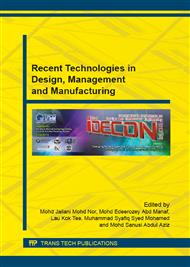p.526
p.531
p.536
p.545
p.550
p.555
p.560
p.566
p.571
A Conceptual Framework in Determining Manufacturing Complexity
Abstract:
This paper proposes a conceptual framework in determining manufacturing complexity. Manufacturing complexity is divided into five main components which are product behaviour, infrastructure capability, production planning, information management and personnel perception. These five main components then divided into twelve sub components. Lastly all these components are classified in two categories which are internal complexity and external complexity. These components are interrelated, such that a bi-directional relationship exists between internal and external complexity. The conceptual framework initiated in this paper can be used by manufacturers to gain more understanding on manufacturing complexity. Thus manufacturers can take proper actions to align themselves with the issues brought forth by manufacturing complexity.
Info:
Periodical:
Pages:
550-554
Citation:
Online since:
May 2015
Keywords:
Price:
Сopyright:
© 2015 Trans Tech Publications Ltd. All Rights Reserved
Share:
Citation:


